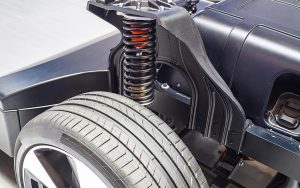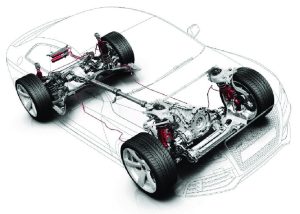Hydraulic suspension systems use fluid pressure — rather than traditional springs — to absorb road impacts and adjust ride height. This design delivers unmatched ride quality and adaptability, making it ideal for high-performance luxury vehicles, heavy-offroad use, or specialized suspension tuning.
Overview: How Hydraulic Suspension Operates

At its core, a hydraulic suspension replaces — or complements — mechanical springs and shocks with fluid-controlled cylinders connected to each wheel. Key components include:
-
Hydraulic Pump: Engine-powered pump pressurizes fluid.
-
Accumulators: Gas-filled chambers storing pressure to smooth response.
-
Hydraulic Cylinders/Struts: Replace or work alongside traditional dampers.
-
Control Valves & ECU: Adjust fluid flow, ride height, and firmness via pressure modulation.
-
Fluid Reservoir: Houses hydraulic fluid for continuous operation.
Mechanism of Action
When a wheel hits a bump:
-
Fluid shifts through valves between chambers.
-
Compressed gas absorbs and cushions force.
-
Fluid is forced back — damping the motion and keeping the tire planted.
Height, stiffness, and damping respond instantly based on pressure, offering near-instant adaptation — much faster than spring-based systems.
Advantages & Challenges
Benefits:
-
Superior comfort: Fluid’s smooth action absorbs road imperfections better than coil or air springs.
-
Instant level control: Each corner adjusts independently for ride height and stance.
-
High response speed: Excellent for performance or off-road driving.
-
Precision control: In advanced systems, ride firmness adjusts dynamically, even under extreme maneuvering.
Limitations:
-
High cost & complexity: More expensive to produce and maintain.
-
Leak risk: Hydraulic fluid leaks, seal failure, or system bleeding are critical issues.
-
Not as plush as air suspension: Often firmer; lacks softness of airbags.
Real-World Applications
Luxury & Performance:
Mercedes-Benz Active Body Control (ABC) uses hydraulic servomechanisms and sensors to counter body roll, dive, and squat in real time, improving cornering stability dramatically.
Off-Road SUV Technology:
Lexus KDSS (Kinetic Dynamic Suspension System) uses hydraulics to disengage stabilizer bars on uneven terrain, increasing wheel articulation and grip.
Emerging Tech:
Systems like ClearMotion’s proactive suspension adjust individual wheels via hydraulic actuators in response to road irregularities detected by sensors. This proactive method significantly improves comfort on rough roads.
Comparison: Hydraulic vs. Other Systems
| Suspension Type | Comfort | Response Speed | Adjustability | Maintenance |
|---|---|---|---|---|
| Coil Spring + Damper | Good | Fixed | Low | Low |
| Air Suspension | Smoothest | Moderate | Moderate–High | Moderate–High |
| Hydraulic Suspension | Excellent | Very Quick | High (dynamic control) | High |
Hydraulic systems offer faster and more precise control than air suspension, especially when combined with active control electronics.
Maintenance & Durability Tips
To ensure longevity:
-
Check hydraulic fluid and seals regularly.
-
Replace filters and top up fluid per OEM schedule.
-
Monitor for leaks around valves, cylinders, and accumulators.
-
Have access to trained technicians — hydraulic systems require specialized service.
Is Hydraulic Suspension Right For You?

Ideal For:
-
Sedans or SUVs needing precise height control, such as luxury or smooth-road vehicles.
-
Off-road or utility vehicles demanding adaptive handling or clearance.
-
Custom builds or performance rigs needing rapid suspension responses.
Not ideal for budget builds or those prioritizing lowest servicing cost — air suspension or upgraded coilovers may suit better.
Cost Estimates
| Component/System | Typical Cost (EUR) |
|---|---|
| Hydraulic suspension kit | €1,500 – €5,000 |
| Hydraulic pump/actuator unit | €300 – €700 |
| Accumulators (per unit) | €100 – €300 |
| Reservoir + dampers/lines | €400 – €800 |
| Professional installation | €500 – €1,200 |
Upgrade Path & Where to Buy
If your setup requires smoother ride control, lift/lower capability, or better road adaptation, consider kits built for your vehicle type. Match components with proper pump capacity, valves, and compatibility. Buy Suspension online
Whether rebuilding classics or enhancing modern vehicles, choose high-quality hydraulic suspension parts designed for stability, comfort, and precision.
Final Thoughts
Hydraulic suspension systems are a powerful alternative to traditional springs, offering smooth ride, dynamic height control, and rapid response. Despite higher cost and maintenance needs, they offer unmatched adaptability in extreme driving situations. If ride quality, adjustability, and performance are priorities, hydraulic systems deliver real advantages over coil and air suspension setups.